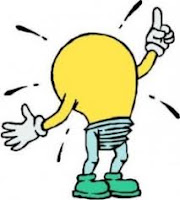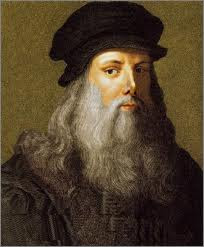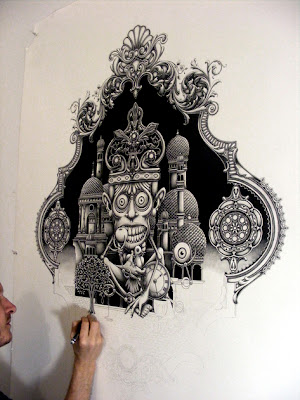The material used to make art is called medium.
Did You Know That....:
You need to know that the word medium has an unusual plural form. It is media. Clay, wood, and marble are media used for sculpting.
~Art Talk
Just as the artists' choice of how to arrange the elements of art using the principles of design affects the look of the finished work, so do the medium and the process the artist chooses.
Lets describes some of the most familiar media and processes.
- Drawing
It is the process of moving a pointed instrument over a smooth surface to leave a mark. That mark is a line.
- Line is the most important element of art in drawing.
Did You Know That....:
The most popular drawing media are graphite pencils, colored pencils, marking pens, charcoal, crayons, pastels and colored chalk, pen and ink, pen and brush,, and brushes, with watercolors are also used to make drawings.
~Art Talk
The Preacher by Charles White is an example of a finished work of art drawn with a pen and ink.
Preacher by Charles White
1952
Ink on cardboard
21" X 29"
Whitney Museum of American Art
1952
Ink on cardboard
21" X 29"
Whitney Museum of American Art
The artist has built up the dark areas in his drawing by carefully applying layers of lines that cross each other in different directions. It is easy to see the lines in the gray shadows, but some areas appear totally black.
Born Charles Wilbert White on April 2, 1918, in Chicago, IL; died on
October 3, 1979; married Elizabeth Catlett (divorced); married Frances
White; children: one son, one daughter
Education: Art Institute of Chicago, 1937; Art Students League, New York; Taller de Grafica, Mexico.
Military/Wartime Service: Army Corps of Engineers, corporal, 1941.
Memberships: Executive board, Black Academy of Arts and Letters; Otis Art Association; National Conference of Artists; Pasadena Society of Artists; National Academy of Design; board of directors, National Center of Afro-American Artists.
Education: Art Institute of Chicago, 1937; Art Students League, New York; Taller de Grafica, Mexico.
Military/Wartime Service: Army Corps of Engineers, corporal, 1941.
Memberships: Executive board, Black Academy of Arts and Letters; Otis Art Association; National Conference of Artists; Pasadena Society of Artists; National Academy of Design; board of directors, National Center of Afro-American Artists.
For More Details Visit:
Another example, a Filipino artist that created a drawing wherein it's easy to see the lines in the gray shadows, but on the upper part appears totally black.
 |
Pen & ink drawing by Ben Cabrera from the series
"Images of Women in the Cordillera", published by CWERC Inc., 1989.
|
Meet the artist:
Benedicto Reyes Cabrera (born April 10, 1942), better known as "Ben Cab", is a Filipino painter and was awarded National Artist of the Philippines for Visual Arts (Painting) in 2006. He has been noted as "arguably the best-selling painter of his generation of Filipino artists."
BenCab was born to Democrito Cabrera and Isabel Reyes in Malabon,
Philippines on April 10, 1942. He was the youngest of nine children.BenCab's first exposure and discovery of the arts happened through his
elder Brother Salvador, who was already an established artist during
Bencab's childhood.
For More Details Visit:
Different purposes for drawing:
- to develop perception
- to record ideas
- to help plan projects
- to make finished artworks
- Looking and Perception: How do it differs?
To an artist, looking and perception are not the same thing. Looking is simply noticing and labeling an object while perception is the act of looking at something carefully and thinking deeply about what is seen.
Developing perception requires that you really study the object being observed and that you notice every detail carefully. Through drawing artists become better at perceiving.
- Artist used sketchbooks to record their ideas.
Many artists use sketchbooks to record their surroundings to study objects. The Rennaissance artist Leonardo da Vinci filled more than one hundred sketchbooks with his perceptions and ideas.
Meet the artist:
 |
| Woman's Head By Leonardo da Vinci |
Meet the artist:
Italian painter, draftsman, sculptor, architect, and engineer
whose genius, perhaps more than that of any figure, epitomized the Renaissance humanist ideal. His "Last
Supper" (1495-97) and "Mona Lisa" (1503-06) are among the most
widely popular and influential paintings of the Renaissance. His notebooks
reveal a spirit of scientific inquiry and a mechanical inventiveness
that were centuries ahead of their time.
For More Details Visit:
- To help a finished artworks.
Drawing is usually the first step in completing many paintings and other art projects. Rough sketches, or studies, are almost always done before creating a work in another medium such as paint or clay. Fashion designers draw their ideas for new styles long before any fabrics is cut. Many creative people such as stage designers,graphic designers, and architect, must show presentation drawings for client's approval.
Another example, Artist's Drawing from various artist by using pencil and other drawing media.
Meet the artist:
Another example, Artist's Drawing from various artist by using pencil and other drawing media.
Joe Fenton has worked for several years in the film industry
for Disney and other studios as a concept artist. He is from London, England,
but currently resides in Brooklyn, New York. This is his first picture book.
For More Details Visit:
http://authors.simonandschuster.com.au/Joe-Fenton/46761976/biography
Source: Art Talk-Second Edition
Thanks for reading! My next post will be about media and processes of art (painting).








No comments:
Post a Comment